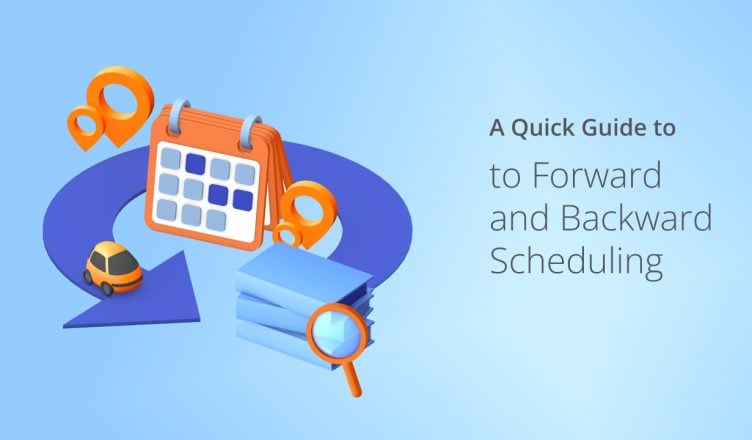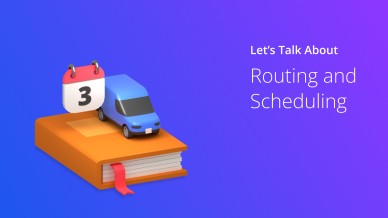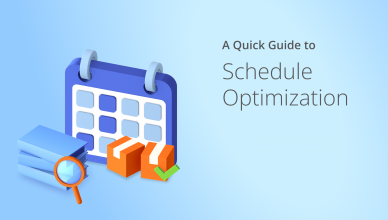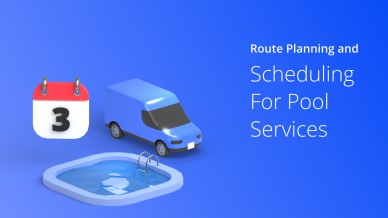Forward and backward scheduling are the two most crucial techniques to master when it comes to scheduling issues and missed deadlines.
The consequences of poor scheduling in business result in workplace stress, poor productivity, and conflicts with customers. Missed deadlines could even cost you those customers.
Your purpose should be to optimize workflow within your organization to offer top services to your customers. Learn how both scheduling methods can help you achieve your goals. But first, let’s get to the basics.
Table of Contents
What Is Forward and Backward Scheduling?
Companies use either backward or forward scheduling to efficiently plan production or allocate resources. But which method would be helpful for your business?
In this section, we compare forward and backward scheduling to decide on which method will work for your organization.
What Is Forward Scheduling?
Forward scheduling is a method used to plan and complete tasks as quickly as possible. The purpose is to complete a project before its due date. Most organizations use forward scheduling to help teams meet deadlines, increase workflow, and generate more orders.
The process of forward scheduling is pretty simple. Tasks are arranged with specific due dates, and resources are allocated to each one. This scheduling method is particularly useful in production and manufacturing. It ensures that each step in a task’s process is completed on time and successfully when resources are available.
Forward Scheduling is dependent on the availability of resources and capacity. For example, if you have an order for custom resin earrings, you can begin production when the resin is available. If the resin is in stock, you can immediately start working on the earrings. Your customers will then receive their order as soon as you’ve made their products.
What Is Backward Scheduling?
Backward scheduling is slightly different to forward scheduling. This method is also known as just-in-time manufacturing. Production orders are scheduled according to your customers’ requested delivery date.
Therefore, when a customer places an order with a specific deadline, you and your team must ensure that production is scheduled to meet that deadline.
With backward scheduling, you have more flexibility, and it allows you to make last-minute changes or customizations before sending out orders.
Want To See For Yourself How Route4Me Can Boost Your Profits?

The Difference between Forward and Backward Scheduling
The difference between the two scheduling techniques is simply the time and date you need to complete tasks based on the delivery date. Depending on what type of business you run, you may need to incorporate forward or backward scheduling into your production and delivery line.
Both methods have their advantages and disadvantages.
Forward scheduling is ideal if you want to complete tasks quickly to bring in more work. The more work you complete, the more profit you make. It also shortens your to-do list, which eliminates workplace stress.
On the other hand, forward scheduling provides less flexibility, so you may struggle to adjust when you’re experiencing shortages. Team members may struggle to fulfill orders which can cause a stressful and chaotic working environment.
Backward scheduling is more structured and allows you to organize your processes effectively. You can include possible delays and shortages in your delivery time, which can relieve some of the pressure from you and your team.
However, there can be unexpected delays using backward scheduling. For example, delivery drivers may get stuck in traffic, or you won’t receive your resources on time. This causes a risk of under-delivering.
Which is Better?
So which method is better for your business, forward or backward scheduling? Well, it depends on the type of organization you have. Both methods can be beneficial for your business, but it will depend on the type of your service offerings and how much pressure it will place on your team.
Production tasks may need both forward and backward scheduling to control and optimize workloads.
However, you must remember that you can’t change or customize orders with forward scheduling before sending them out. With backward scheduling, you must commit to a specified delivery date and have a strategy for delays.
How Can the Scheduling Techniques Benefit Businesses?
Both backward and forward scheduling have their benefits. It’s important to know what these advantages are to properly compare the two methods. You’ll realize that even though these scheduling strategies have fundamental differences, they both offer elements your company can benefit from.
The Benefits of Forward Scheduling
- Maximize the use of your labor force
- Eliminate slack time by redistributing resources
- See where you have room to accommodate new orders
- Easily schedule tasks manually
- Complete tasks before the specified due date
- Slot in additional work
The Benefits of Backward Scheduling
- Shorten your lead times
- Maximize the efficiency of production
- Increase customer satisfaction with scheduled delivery times
- Lower inventory levels and inventory cost
- Save materials because they’re used only when needed
It may be challenging to choose one scheduling method over another to have a combination of both. Forward and backward scheduling can benefit your business if you utilize the two methods correctly.
How Can Route4Me Help with Scheduling?
Your drivers will find it challenging to show up on time without forward and backward scheduling. Luckily, an advanced route optimizer like Route4Me can help you here.Route4Me route plannercan help you schedule all types of field services. And you can plan and schedule routes weeks or months in advance in seconds.The
multi-stop route planner considers weather, traffic, sunrise and sunset times, roadblocks, load, weight, and more constraints while planning routes. Therefore, your drivers will always get well-optimized routes with accurate directions.
You can even amend the routes at any time to accommodate last-minute changes.
Learn in detail about how Route4Me’s vehicle routing software can help with schedule optimization.
However, Route4Me’s delivery scheduling software isn’t limited to just route planning.
You can use Route4Me’s route optimization software to monitor your vehicles in real-time, update your customers about their order status, track fuel consumption and driver performance, and do much more.
Learn six reasons why you need delivery management software like Route4Me.
Conclusion about Forward and Backward Scheduling
Forward and backward scheduling in operations management are simply strategies that tell you when a job can be completed versus completing a task when required. Both the scheduling techniques can help improve your company’s processes to increase your profits and even save money on materials and resources.
However, remember, planning is only good on paper. Even the well-thought-out plans can go for a toss when unanticipated situations arise. Therefore, you need advanced routing software like Route4Me that can help you tackle all the challenges and make field service operations management a breeze.
You can plan accurate routes, ensure balanced workload distribution, track vehicles, and do much more to stay on top of everything.
Don’t just take our word for it. Sign up for our seven-day free trial and see how Route4Me can help you transform your operations.
Want To See For Yourself How Route4Me Can Boost Your Profits?




